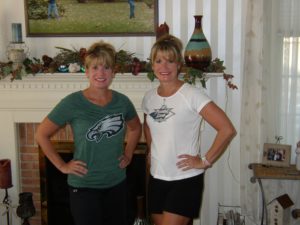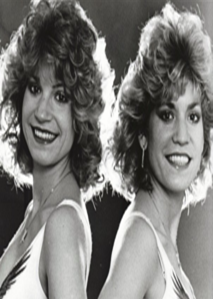
Greetings, Science Cheerleader fans! We have a two-for-one interview for you: Kim and Kelly are former Philadelphia Eagles cheerleaders, science professionals, and twins! Read on to learn about their adventures as twin Science Cheerleaders–twice as nice!
So what got you two into science?
Kim: My science related career evolved over time. My initial work was on the business side with ExxonMobil. Later I managed operations in a facility which included safety, health, and environmental compliance and I really enjoyed the learning curve of the vast environmental regulation arena. This experience allowed me to eventually move into a position as an Environmental Advisor, in which I support the company’s Lubricant Blend Oil Plants in their environmental sustainability initiatives and environmental compliance.
Kelly: After teaching 3rd grade for nine years, a position opened up in my school building for a 6th grade science teacher. I jumped at the chance to challenge myself to teach and become an expert in one subject area instead of teaching all subject areas. I took many classes, training, and in-service workshops in preparation for teaching science.
Got to confess, this is the first time I’ve interviewed twin Science Cheerleaders. What was that experience like?
Kim and Kelly: There were three sets of twins that made the Philadelphia Eagles Cheerleading squad in 1984 – that was very unusual. We were asked to participate in several activities associated with our “twin-ship”; television appearance on a day-time talk show about twins, newspaper interviews regarding twins, and personal appearances for “Moms with Twins” to share our experiences. We are still very good friends with the other twins today. Regarding the science arena, I (Kim) enjoy going to Kelly’s school during Career week each year to talk about my science-related job, and watch her students’ expressions when they are “seeing double.”
Best part of your day jobs?
Kim: I support our ExxonMobil Lubricant Blending plants (they make all those Mobil 1 products) and travel to those plants within our network in North and South America. I enjoy meeting other employees within the company, and experiencing new cities and diverse cultures. I like getting out of the office and on the plant floor in my hard hat, steel-toed safety shoes, and safety glasses and interacting with the operators at the plants.
Kelly: I teach several science classes throughout the day and language arts in the afternoon. The units the students are engaged in are: Magnets and Motors, Light and Color, Measuring Time, and Solar Energy. I enjoy getting the students excited about conducting experiments, gathering data, critiquing claims, and sense-making. The students get to debate the data and “talk” about what is happening. They take apart motors, build electromagnets, pinhole cameras, water heaters, and solar houses. They design solar cookers and cook with the energy from the sun. They change variables on different measuring devices that man has used. All of this adds up to exciting science in the classroom. My classes do not look like a reading class….it is all a hands-on learning environment.
 You both cheered for the Philadelphia Eagles. I know Kim cheered for three years. Kelly, how long were you on the squad, and whose idea was it for you to try out to be professional cheerleaders?
You both cheered for the Philadelphia Eagles. I know Kim cheered for three years. Kelly, how long were you on the squad, and whose idea was it for you to try out to be professional cheerleaders?
Kim: Kelly also cheered for three years and it was her idea to try out for the squad. We were both in our senior year at college when she called me and asked if I wanted to try out with her for the Eagles cheerleading squad. We knew we’d both be moving home after college, pursuing careers, and so…why not? It was the next step to remaining active after college. From each of our respective colleges, we traveled to tryout practices for over one month, and only told our parents what we were up to after the final night of tryouts when we “made” the squad.
Kelly: Kim and I cheered in high school and I also cheered in college. I competed collegiately in gymnastics, so I knew I wanted to continue dancing and cheering. I also love the sport of football!
Which came first, your interest in science or cheerleading?
Kim: For me, cheerleading came first since I cheered while in elementary school for the pee-wee and junior teams in the community. My science-related career evolved over time due to my job progression, which proves that it’s never too late to get involved in science.
Kelly: I always loved to cheer, dance, and flip around, so I would have to say cheerleading. However, once I took on the challenge of teaching science, I realized how much positive impact I could make on students who may not like the subject of science. Now I share both interests equally.
Do you find that stereotypes about cheerleaders (or twins) helped or hindered your studies or professional experiences?
Kim: Having the experience of NFL Professional Cheerleader on my resume never impeded my job opportunities. It often provoked conversation during job interviews – people are just curious. Remember, the word “leader” plays a role both on and off the field!
Kelly: The stereotype helped in my field. Parents were always curious and still ask me about cheering professionally…especially if the Eagles were their favorite team! My enthusiasm, confidence, and energy on the field help when I am teaching. It lets the students know that I am passionate about what I teach which affects them.
Best cheerleading experience?
Kim and Kelly: Back in 1984, making the Philadelphia Eagles Cheerleading squad itself was a thrilling experience. Now, 28 years later, we are part of a large group of local NFL Cheerleader Alumni that participate in many charity events and fundraising activities. One of these opportunities consisted of five decades of alumni cheerleaders from the 1960s to the 2000s, performing a rehearsed dance in which we made a video and raised $100,000 for breast cancer research http://www.youtube.com/watch?v=cfRSDbV8Adw. We have performed at the Philly Soul Football games, and at NCAA Women’s Basketball Pink Zone games to bring awareness to breast cancer. We wore a pink ribbon uniform, used pink pom-poms and danced with several breast cancer survivors. This is especially meaningful to us because our mom is a breast cancer survivor. Not only do these events keep us active and in shape today, but the volunteer work, giving back to the community, is our most current rewarding cheerleading experience.
Best science-related experience?
Kim: I don’t have one single great science experience because every day I get to go to work for a global company that supports continued technological innovation to provide a reliable source of energy for the future. I feel lucky to work for ExxonMobil, a company that also has a goal to increase opportunities for women pursing degrees in science fields and sponsors programs like the National Math and Science Foundation, “Introduce a Girl to Engineering” events, and other science and math outreach programs.
Kelly: Over the past three years I have been part of a program titled MISE (Merck Institute for Science Education). This Academy of Leadership in Science is supported by Merck Pharmaceuticals. My school district chose a team of educators to attend conferences each summer in Princeton to learn about best practices and more effective ways to teach science. We then bring this information back to our school to share with our colleagues. As we continue to create and work with a school-based plan, we become better science teachers, which have optimistic, constructive impacts for our students.
Do you have any advice for youngsters who might feel torn between following one dream and another?
Kim: Be confident and dream big! There’s no reason you can’t do both. Majoring at college in science, math, or other high tech fields are pre-reqs for many good jobs in today’s society. These college majors may be stressful at times. Balance that work load with something else you enjoy like your favorite sport or activity, and that includes cheerleading.
Kelly: Do both!! Do what you love and surround yourself with people who support your decisions. When people find out that I was an NFL cheerleader AND that I teach science, they are amazed. Wow! You can dance and be smart too. Be proud of that!!!
Along these lines, what advice would you give your 12-year-old selves?
Kim: Pursue something you enjoy. If you can fit science, math or technology in it, that’s even better. There are a million opportunities out there, but you need a solid foundation of science and math. Experiment with science: go on science class field trips, join an Envirothon group where learning takes place through outdoor hands-on team work, sign-up for a summer science camp. These activities may open your eye to new possibilities and give you a new perspective in achieving your goals. Challenge yourself now – you can achieve anything if you work hard!
Kelly: Try science classes in school. Learn more about all different types of sciences because they are vast and very different. Try to visit scientists and see what they really do. Some are walking on volcanoes, some are diving in the ocean, others are in labs working with chemicals, and some scientists are helping law enforcement solve murder mysteries.
What’s something people might find especially surprising about the two of you?
Kim and Kelly: We were married within a few months of each other and had our first children within a few months of each other as well. We have sister who is eleven years younger than us, and she DID major in biology/ecology sciences and is employed by Sanofi-Pasteur doing microbiology work!
Why do you want to be Science Cheerleaders?
Kim: I want kids to know that education in science, engineering, and math can be a key to their futures – the world relies on technology and innovation. Students should understand what sustainability means in today’s world; addressing the challenges of balancing economic growth, social development, and environmental protection so future generations can live in a world that is not compromised by the actions we all take today. I want to impress upon them that even at their age now, they CAN make a difference. There may be kids out there that like science and math, and know they are good at it. I want to ensure students are aware that there are jobs in the sciences for them.
Kelly: At the beginning of every school year I ask my students to draw a “scientist.” Predominantly this is what they draw: the scientist is MALE, has bad hair, wears a lab coat, and either holds chemicals in a test tube or is blowing something up. I want to change this stereotype in my students’ minds before they leave my classroom at the end of the school year. We discuss why more of the students are not drawing FEMALE scientists! And why can’t the scientist be doing work outdoors, and not be having a bad hair day? I want all of my students, both male and female, to know that community, country, and global issues can be solved through science. This is the message I want to get across, especially to girls! We are go-getters. Females can accomplish great things. My passion, energy, and ability to relate to youngsters is an asset that can definitely be shared with the next generation of scientists!

